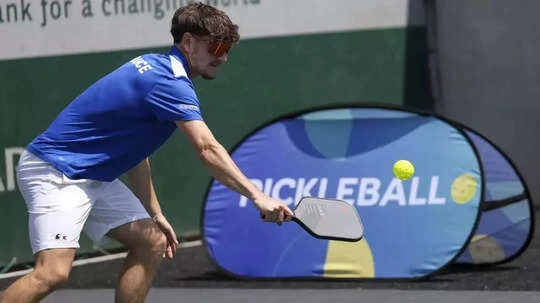‘Dink’ is one of the first unusual pickleball terms you will hear on the courts. It is also among the game’s most crucial and calculated shots.
I will go over all you need to know about pickleball dinks in this article, including when and how to hit them. I will also offer advice on how to make the most of them.Pickleball players “dink” when they make a soft, controlled shot that lands in their opponent’s non-volley zone, or “NVZ” (also referred to as the “kitchen”). The 7′ feet space from sideline to sideline and on either side of the net is the kitchen. When volleying the ball-that is, striking it without allowing it to bounce-players are not permitted to enter the kitchen. It takes practice to hit precise shots into this area (dinks) so that they land gently and are impregnable.The dink, which capitalizes on pickleball’s distinguishing feature-the impossibility of running straight up to the net and smashing the ball due to non-volley zone regulations-is arguably the most basic stroke in the game. A dink is a shot that bounces in the other kitchen after being hit from the kitchen line. Dinks are typically unattackable shots since your opponent must wait for it to come to them instead of sprinting into the kitchen and striking it before it bounces.
How To Hit A Dink Shot?
You should be at or near the kitchen line if you want to hit a good dink. Hold your paddle out in front of you while bending your knees and assuming a low body position. Dinking calls both control and dexterity. When you make contact with the ball, lift with your legs while maintaining a gentle hold. You do not have to swing forcefully. To raise the ball just over the net, you must produce a soft, deliberate upward tap.Get comfortable creating repeatable, dependable dinks that consistently land in the NVZ. Your opponents must come up with their own return shots because these shots do not have much pace, which might lead to mistakes. Make a note of your opponent’s weakest side and use your dinks to attack it. Make careful to return to your initial, neutral position (around the center of your side of the court) after doing each dink. This will help you better predict how your opponent will react and adjust your strategy accordingly.Avoid getting sucked into a dinking rally where you end up in the same place. This gives your opponent a gap to strike into and exposes the middle. Get back into your ready position so you can respond to the following shot with a balanced stance and slightly bent knees. Use a variety of depths, angles, and directions to mix up your dinks. As you get better, you may start adding spin to your dinks. Your game will become more unpredictable if you can keep your opponents guessing.When you and your opponent are at the NVZ line, dink rallies usually begin. Depending on the depth of the incoming stroke, players may volley the ball before it bounces or wait for it to bounce. Instead of moving back to allow it to bounce at your feet, you typically hit it before it bounces when you receive a deep dink. In any case, a “dink war” is a back-and-forth exchange of controlled, soft shots across the goal.Every pickleball player must become proficient in dinks, which are basic, strategic shots. They assist you in establishing offensive plays, slowing down the game, and regaining control. Dinks positioned correctly can open doors or make your opponents make mistakes.
